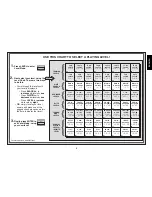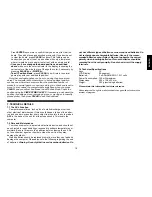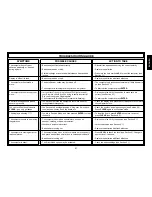
13
ENGLISH
the number of moves the computer has examined so far
• The move currently being considered
• The search speed, or number of positions (nodes) being searched
every second
Press WHITE/
<
to scroll backward and see previous displays again.
Press CLEAR to return to the normal clock display.
4.3 Chess Clock Information
Press INFO a third time for chess clock information. The chess
clocks keep track of the time for both sides. Press BLACK/
>
repeat-
edly to scroll forward through the clock displays:
• Elapsed time since the last move was made
• Total elapsed time for the computer
• Total elapsed time for the player
• Remaining time for the computer
(Blitz/Tournament Levels only)
• Remaining time for the player
(Blitz/Tournament Levels only)
Press WHITE/
<
to scroll backward and see previous displays again.
Press CLEAR to return to the normal clock display.
The clocks stop whenever you take back a move, check level set-
tings, select options, verify or set up a position, or turn the unit off. In all
these cases, however, the times are retained in memory, and the clocks
resume as soon as play is continued. Whenever you change levels or
press CLEAR and ENTER together to reset for a new game, the chess
clocks are always reset to
0:00:00
.
4.4 Move Count/Game Moves
Press INFO a fourth time to show the move number in the game so
far. You can then press WHITE/
<
repeatedly to scroll backward back
through the moves of your game (up to 30 individual moves).
• Number of White moves played so far
• Moves of the current game
Press BLACK/
>
to go forward through the moves again at any
point. Press CLEAR to return to the normal clock display.
4.5 Want a Hint? Just Ask!
In case you missed this feature when it was mentioned in Section
4.1, we wanted to point it out again—if you ever need advice on a
move, you can always ask the computer for a hint. Simply press INFO
when it’s your turn to move, and the computer will show a suggested
move for your side!
5. OPTIONS FOR FUN AND VARIETY
In addition to all the features you’ve learned about so far, your chess
computer also offers many other exciting game options! All of these
options are user-selectable at any time during a game. They are de-
scribed individually in this section, and summarized in the Option Mode
Chart.
Selecting Game Options
There are two methods of setting options, as described below—by
using the game keys or pressing board squares.
See “THE BASICS OF OPTION MODE: HERE’S HOW!” for a
chart summarizing how to use Option Mode, and an overview of
all the options.
The Game Options are divided into three groups:
Operation Mode,
Playing Mode, and Rotating Display Mode. Pressing OPTION cycles
from one group to another. Each group contains eight different options,
and the BLACK/
>
and WHITE/
<
keys are used to cycle through the
options within each of the groups. For each option, a plus (+) in the
display indicates the displayed option is ON, and a minus (–) means the
option is OFF. Press ENTER to turn each option on or off as it is
displayed. Remember that pressing OPTION cycles through the three
main groups, so you can switch to any of the groups at any time. After
you have made all your option selections from any or all of the option
groups, press CLEAR to return to normal game play.
Another method of selecting game options is by pressing the option
squares. As shown in the Options Chart, Squares A1-H1, A2-H2, and
A3-H3 can be used to turn options on and off. First, press OPTION to
enter Option Mode; then take a chess piece and press the desired
square to access any option, using the chart as a guide. You’ll see that
pressing a square repeatedly turns that option on and off again, with
plus (+) for ON and minus (–) for OFF. Once you have made all your
selections, press CLEAR to return to your game.
When the computer is first powered on, certain default options are
set. Options which are automatically in effect at the first startup are
shown in the chart with a plus, and options which are off are shown
with a minus. Whenever you reset the computer for a new game, most
of your selected options are carried over to your next game. Some




























